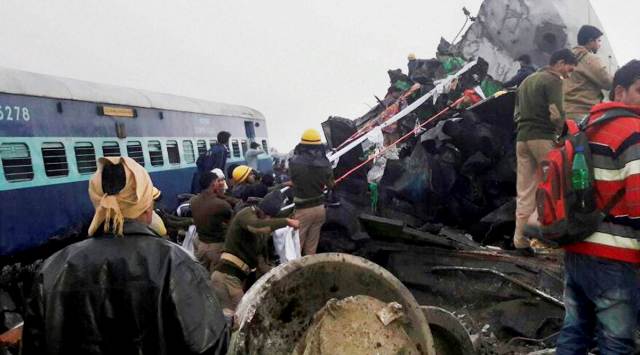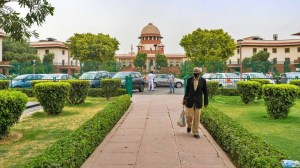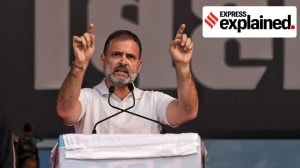- India
- International
In 2016 train accident, Panel finds welding fault but adds caveat: wait for the NIA sabotage probe
The report says that a part of the welding on a coach gave way due to corrosion, fell off, and got “embedded” in the track, creating an obstruction in movement as the train was speeding at 106 km per hour.
 Rescue and relief works in progress after the Indore-Patna express derailed near Kanpur Dehat on Sunday morning. (PTI Photo/File)
Rescue and relief works in progress after the Indore-Patna express derailed near Kanpur Dehat on Sunday morning. (PTI Photo/File)THE PROBE into the derailment of 14 coaches of the Indore-Patna Express that killed 152 passengers on November 20, 2016 near Kanpur was handed over to the National Investigation Agency amid suspicions raised by the government attributing the accident to terrorist sabotage. Then Railway Minister Suresh Prabhu had said there was “possible criminal interference by outsiders” and at a UP election rally, Prime Minister Narendra Modi, too, called it a “conspiracy”.
While the NIA probe is still on — no chargesheet has been filed yet — the final report of the Commissioner of Railway Safety is in. And it identifies a sudden catastrophic mechanical failure as the “probable cause”.
The report says that a part of the welding on a coach gave way due to corrosion, fell off, and got “embedded” in the track, creating an obstruction in movement as the train was speeding at 106 km per hour. Two coaches “took off” from the track and became a “projectile at high speed”, and fell on a third coach. All of this happened within three seconds around 3.02 am.
The CRS report, which was submitted in June this year and is currently under consideration, has an unusual caveat. It says that its conclusions are valid only “if sabotage is ruled out by NIA”.
“The report of their (NIA) investigation has not been submitted to the CRS, Kolkata Circle so far. The Railway Board has also not forwarded any investigation report of NIA to CRS… Hence, it is not possible to conclude the cause of the accident,” states the report. The report was authored by the then CRS Eastern Circle P K Acharya, who is now retired.

In the run-up to the UP assembly elections in March 2017, Prime Minister Narendra Modi had said: “Gonda is a border district touching Nepal. There was a rail accident in Kanpur, hundreds of people were killed. Some people have been arrested… This was not an accident, it was a conspiracy. Where were the conspirators hiding? Across the border.” He was speaking at a campaign rally in Gonda on February 28, 2017.
The derailment was one of the worst in terms of death toll for train mishaps after the Gaisal accident in 1999 that claimed 290 lives. “S1, S2 coaches taking off from track and becoming projectile at high speed and (falling) on B-3 coach due to very high impact and buffing force resulted in very high casualties in these coaches. The entire happening… from 2.58.01 hours to 2.58.02 (3 seconds)… indicates this was a sudden derailment and capsizing of coaches…not a gradual derailment of wheel climbing,” the probe report states.
It also says that a part of the S-1 coach, which had “severe corrosion, old breakage and poor quality of welding”, fell down after Pukhrayan station when the train was at 106 km per hour. “The head stock embedded in track, causing intense obstruction to the movement of coaches,” the report states.
When contacted, P K Acharya told The Indian Express: “I said (in the report) that if the NIA finds out that it was a case of sabotage then anything could happen. However, in the event that it finds that there was no sabotage, then these could be the cause. I will not be able to say anything on the report as I have retired.”
Acharya retired in July 2018 after completing the probe and submitting his findings, which have been formalised now. He said that there is no further technical evaluation needed. “We took time because we did a lot of evaluation. We even ran tests on prototypes in Howrah, etc,” he said.
Acharya says he submitted a preliminary draft report within a month of the accident, as per the rule. The commission returned it to him in January 2017 for further “deliberation/consideration” on technical points, the final report notes.
The report rules out the possibility of a simple rail fracture on multiple grounds: four trains passed the spot without reporting any abnormality in the track; the drag marks of the derailed coach was not as long as it should have been in a case of rail fracture.
“All the fracture faces of rails were crystalline in nature indicating sudden breakage had taken place due to sudden service impact… From above discussion, accident due to rail fracture is ruled out,” the report states.
The report also relied on witness accounts of the train’s driver who said that after crossing Pukhrayan he noticed that the overhead equipment was shaking and the brake pressure of the engine was dropping. He immediately applied emergency brakes, he said.
Among others, the probe also quoted the account of Prakash Kumar Pandey, a passenger and BTech student of mechanical engineering, who was injured and hospitalised in Kanpur. Pandey told investigators that he was awake at night and could hear “heavy sound coming from S1 coach” after Jhansi and also before the accident.
The NIA was handed over the probe after Prabhu wrote to then Home Minister Rajnath Singh in January 2017.
Prabhu in his letter had listed out six recent instances of rail mishaps: Hirakhand Express derailment near Kuneru station in AP; two goods trains that went off the track on the Koraput-Kirandul section; discovery of a “cooker bomb” at Ghorasahan station; detection of deep cuts on tracks near Kanpur on January 1; and the obstruction on tracks on a rail bridge between Barauni-Samastipur stations on Monday.
Citing the derailment of Indore-Patna Express, Prabhu’s letter said: “Bihar police unearthed a conspiracy to train some persons in the country to tamper with railway tracks to cause train derailments and (their) possible involvement in the accident near Kanpur.”
Acharya recorded in the chronology of his report that in January 2017, various newspapers were reporting that “ISI of Pakistan” was behind the accident.
Asked about the probe report and its contents, Chief Commissioner of Railway Safety S K Pathak said: “I will not comment on the matter.” The Commission of Railway Safety functions under the Ministry of Civil Aviation.
Apr 25: Latest News
- 01
- 02
- 03
- 04
- 05







































